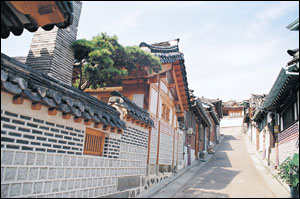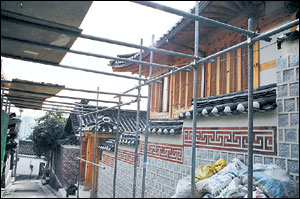The streets of Bukchon village, lined with traditional Korean housing, lead back in time to a long-lost era of "yangban" nobility which existed during the Joseon Dynasty (1392-1910).
It is a tranquil neighborhood of one-story "hanok" that have authentic wooden beams, stone blocks and tiled roofs and lies in the heart of Jongno-gu in central Seoul. But walk one street farther and you will come across a construction site - a jarring reminder of the modern world of concrete.
 |
The house on the left is a "hanok" or traditional Korean house that has been restored in keeping with the authentic architecture of the area in Gahoe-Dong in Seoul. [Jane Cooper / The Korea Herald] |
 |
Many of the buildings in this street in the Bukchon traditional village in Seoul are being knocked down and rebuilt with modern designs. |
"One of the few remnants of the past is being destroyed," says David Kilburn, a British expatriate who has lived in the area since 1988. The hanok that surround his traditional home are in the process of being knocked down and replaced by buildings that he says are not authentic and are rapidly changing the unique cityscape of the district.
This part of Gahoe-Dong is the last place where there are whole streets of hanok, a house design originating from the Joseon era. According to the Seoul Metropolitan Government's website, 520 traditional houses remain, but Kilburn estimates the number is rapidly dwindling to far less than 100.
The area was designated in 1973 as a Korean-style House Preservation District with the aim of protecting the homes from the designs of modern-day architects.
However, Kilburn says hanok that are not beyond repair are being knocked down so that modern, two-story alternatives can be built in their place.
Next door to Kilburn, a house is being built which, he says, is a two-story building that uses modern materials and does not keep to the authentic design of a hanok. "There's no such thing as a two-story hanok! Hanok are not made of concrete and steel," said Kilburn.
The developer, Lee Mun-ho, told The Korea Herald that the building does not have two stories. [Click here to see the picture, and judge for yourself!]
Here lies a difference in interpreting construction terminology and the local government rules of the Preservation District.
Kilburn says that digging into the ground, building a garage as a basement and then choosing to live in it could be one way of avoiding the definition of a two-story building. But wherever the definition of a hanok ends and that of a modern house begins, the house next door to Kilburn's is still much taller.
Kilburn's interpretation of hanok (at www.kahoidong.com) is a "single-story building based on a cubical framework of interlocking wooden beams resting on blocks of stone. Other materials are used to complete the building such as straw, mud, paper and clay."
He has been unable to get information from the Jongno-gu office that details what the laws for the Preservation District actually are.
The construction company, Jaho, received permits from the Seoul Metropolitan Government and Jongno-gu office, and as far as the Jongno-gu office is concerned, demolishing traditional hanok and building new homes in their place is legal.
A Seoul Metropolitan Government official told The Korea Herald that the construction work is monitored before, during and after the process.
But Kilburn remains adamant that the buildings are not traditional hanok. He showed The Korea Herald a commercial license which would allow his neighbor to open a wine bar in what is classified as a protected residential area. When Kilburn took the issue to officials at the Jongno-gu office, he was told that, "There are no proper regulations governing these matters."
Kilburn is concerned that the landscape of Gahoe-Dong is changing outside the realm of public debate or awareness.
Adding to the problem, says Kilburn, is the government's recent change in real estate policy. The measures, aimed at curbing real estate speculation, mean that homeowners have to pay high taxes on their second or third homes. As the tax is directly proportional to the value of the property, speculators in Gangnam would be heavily penalized. Land in Gahoe-dong, however, is relatively cheap.
During the Japanese occupation, the yangban nobility fled the area and gradually the plots were broken up into smaller units which ordinary Koreans came to own. Decades later, as the popularity of high-rise apartments grew, Gahoe-Dong was neglected and developed a reputation as a poor area, says Kilburn.
The area has long been avoided by speculators because the protected area designation limits homeowners and makes the property harder to sell at a higher price, Kilburn says.
He fears that speculators have found a loophole in local government laws and are able to buy land in Gahoe-Dong based on the price of a one-story hanok, knock down the traditional building, build a larger building on the land and resell the property at a higher value.
Kilburn points out that it is possible to build new hanok that are in keeping with the original style. In the street parallel to his, there are homes that have been tastefully renovated, remain at the same level and keep the same design as the hanok around it.
Coming from Britain, which values and preserves buildings of historical value, Kilburn is saddened by the changing landscape of Gahoe-dong. The area has weathered Korea's turbulent history through the Japanese occupation and the Korean War, yet he says it is now being lost to "concrete mania."
"The hanok give us a cultural memory to relate to and evolve from. It's a cultural point of reference. Korea is in danger of removing its history," he said.
By Jane Cooper
2005.10.12